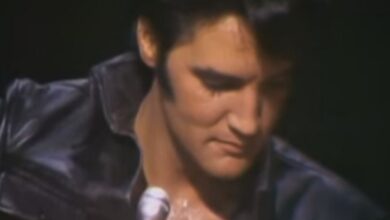Pure Magic, An Astounding Performance From The King Of Rock N Roll… Featuring A Stunning Smile!
Elvis Presley’s performance of “A Big Hunk o’ Love” during the “Aloha from Hawaii” concert on January 14, 1973, represents a pivotal moment not just in his career but also in the larger landscape of rock and roll and televised entertainment. This concert was not merely a performance; it was a cultural phenomenon that showcased the incredible reach of Elvis as an artist and the power of live television. The decision to broadcast the concert live via satellite marked a significant technological advancement in how music and performances were shared globally.
Clad in his iconic white jumpsuit, adorned with sequins and a dramatic cape, Elvis commanded the stage with an electric presence. This striking outfit became synonymous with his later performances and is an enduring symbol of his status as a pop culture icon. His charismatic persona and powerful vocals captivated the audience, creating an atmosphere of excitement and fervor. As soon as he took to the stage, cheers erupted from the audience, which added to the energy of the performance and reflected his immense popularity at the time.
The song itself, “A Big Hunk o’ Love,” is a quintessential rock and roll track that combines a driving rhythm with catchy melodies and lyrics celebrating romantic desire. Originally released in 1958, the song had already established itself as a classic among Elvis’s oeuvre. It reached the top of the Billboard Hot 100 chart, further solidifying his influence on the music industry. This particular performance in Hawaii infused the song with renewed energy, allowing Elvis to reinterpret the classic in a live setting with a contemporary flair.
As he sang, the backup musicians and the chorus of female backup singers enhanced the performance, creating a rich, layered sound that complemented Elvis’s dynamic vocal delivery. The synergy between him and the band was palpable, illustrating the collaborative spirit of live rock performances. The excitement in the venue was almost tangible, as fans were not just spectators but active participants, a sentiment that resonates in live music culture to this day.
The impact of the “Aloha from Hawaii” concert extends beyond its electrifying musical performance. With approximately 1.5 billion viewers tuning in, it was one of the most-watched live broadcasts at the time. This mass viewership showcased how Elvis crossed cultural and geographic boundaries, as people from various countries and backgrounds came together to witness the event. The concert is often credited with establishing the blueprint for future live music broadcasts and global televised events, showcasing the potential for music to unify and entertain on a massive scale.
Elvis himself was experiencing a resurgence in popularity during this period. Despite facing fluctuations in his career through the 1960s, the early 1970s saw a revitalization of his live performances, leading to sold-out shows and renewed interest in his music. The “Aloha from Hawaii” concert served as a powerful reminder of his musical legacy, not just as a performer but as a cultural touchstone whose influence shaped the future of popular music.
In the years that followed, Elvis’s performance styles and his dramatic wardrobe choices would inspire countless artists across various genres. His unique ability to blend different musical styles—rock and roll, gospel, blues, and pop—helped forge a diverse musical landscape that continues to be felt today. The charismatic and flamboyant nature of his performances opened doors for other artists to express themselves with similar passion and creativity.
Elvis had also evolved his musical approach by incorporating elements from various genres, thus significant in the context of expansive Americana and the rock movement. This blending of styles not only attracted a wide audience but also paved the way for subsequent generations of musicians to explore and experiment with their artistic identities.
All these facets come together to ensure that Elvis’s performance of “A Big Hunk o’ Love” in Hawaii remains a celebrated chapter in the annals of music history. It not only encapsulated his fiery spirit and talent but also stood as a beacon of the enduring power of rock and roll. His legacy continues to influence artists around the world and serves as a reminder of the vibrant and transformative nature of live music performance.
As we reflect on moments like the “Aloha from Hawaii” concert, it becomes clear that Elvis Presley was not just a singer; he was a force of nature, a pop culture icon who left an indelible mark on the history of music and entertainment. His ability to connect with audiences, whether through the television screen or in a live venue, set a standard for performance artistry that remains relevant and aspirational for artists around the globe.



